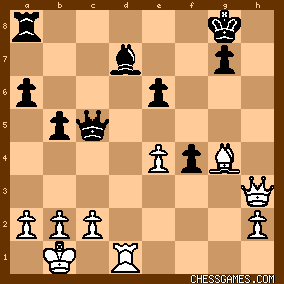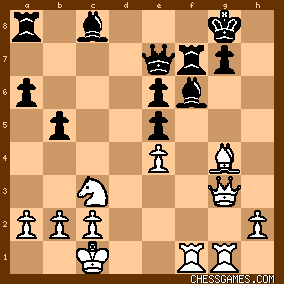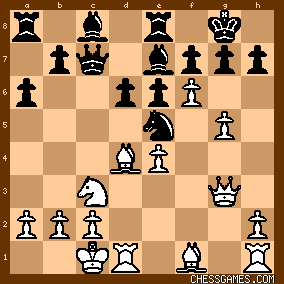|
< Earlier Kibitzing · PAGE 3 OF 3 ·
Later Kibitzing> |
Jan-20-10
 | | Jimfromprovidence: It took me a while to get this and be sure about it, because white has to guard against a back rank mate attempt after say 28...Qc5 below.
click for larger viewBut since the white bishop has the rook's back, it's ok to capture black's bishop. |
|
| Jan-20-10 | | YouRang: *Typo in my last post: I meant <27.Rd1> |
|
| Jan-20-10 | | estrick: @Patriot < How many of us during an actual game, would not hesitate to play 27.Nxf4? "My knight is attacked so I should probably just take his bishop." It's not quite that easy since the e6-pawn is pinned and white wins the piece back. So with black to move 27...exd5 28.Bxd7 dxe4 at least temporarily wins a pawn. A closer look shows that 28...dxe4?? 29.Be6+ wins the house! So the knight isn't really threatened and that leaves the possibility for white to simply improve his position with 27.Rd1.> I was led to the solution because I saw that White’s knight was under attack, and simply allowing it to be taken on d4 would allow Black to undouble his pawns, and create an opposite color bishop situation (which could be drawish?) After confirming the solution, I was surprised to see that in the game Nakamura had played 26. Nd5, threatening Black’s queen, and daring him to take the Knight with the e pawn. Given that 26 . . . Qd6 is apparently a blunder and a losing move, I was trying to figure out why Black didn’t capture the proffered knight on move 26? There is a mating threat after 27 Bxd7 followed by 28 Bf6+ and 29 Qh8#. But it looks as though that threat can be parried if Black simply advances his g pawn, giving his king some room. Can anyone else find a mating attack in this line, or would Black simply have been in a bad way positionally, with an exposed king and White having more active pieces? |
|
| Jan-20-10 | | NakoSonorense: I went for 27.Nf6+, but I'm not sure if I get credit or not. It seems like a good move to me, although probably not as good as 27.Nxf4. |
|
| Jan-20-10 | | MaxxLange: <But it looks as though that threat can be parried if Black simply advances his g pawn, giving his king some room.> I don't think that will help Black much.
26..exd5 27 Bxd7 g6 28 Rf7+ Qxf7 29 Bxf7+ Kxf7
and the Queen is going to be much better than Rook and Bishop with the board this open. |
|
| Jan-20-10 | | MaxxLange: ugh: I mean
26..exd5 27 Bxd7 g6 28 Be6+ Kg7 29 Rf7+ Qxf7 30 Bxf7+ Kxf7 |
|
| Jan-20-10 | | wals: As Rybka 3 1cpu 3071mb hash saw it to
the end
1. e4 c5 2. Nc3 e6 3. Nf3 d6 4. d4 cxd4 5. Nxd4 Nf6 6. Be3 Nc6 7. f4 Be7 8. Qf3
O-O $1 9. O-O-O Qc7 10. g4 a6 11. g5 Nd7 12. Qg3 Re8 13. f5 Nxd4 14. Bxd4 Ne5
15. Bh3 b5 16. g6 hxg6 17. Bxe5 dxe5 18. fxg6 Bf6 19. Rdf1 Qe7 20. Rhg1 Rf8 21.
gxf7+ Rxf7 22. Bg4 Bg5+ 23. Kb1 Rxf1+ 24. Rxf1 Bf4 25. Qh3 Bd7 26. Nd5 Qd6 27.
Nxf4 exf4 28. Rd1 Qc6 29. Rxd7 Re8 30. Rd4 e5 31. Rd7 Qb6 32. a3 f3 33. Qxf3
Qf6 34. Bf5 g6 35. Qg4 Re7 36. Rd8+ Kf7 37. Qh3 Re8 38. Qh7+ Kf8 39. Qh6+ Kf7
40. Rd7+ Re7 41. Bxg6+ Qxg6 42. Rxe7+ Kxe7 43. Qxg6 1-0 |
|
| Jan-20-10 | | RandomVisitor: 3 imprecise moves in a row by black, starting at move 22, and white has a solid advantage. Perhaps 22...b4 was better

click for larger view Rybka 3:
<[+0.26] d=23 22...b4> 23.Ne2 Bb7 24.Qh3 Bg5+ 25.Kb1 Rxf1+ 26.Rxf1 Re8 27.Ng3 Bc8 28.Qh5 Rd8 29.Be2 Bf4 30.Bc4 Qg5 31.Qf3 Kh7 32.Ne2 Be3 33.h4 Qh6 34.Qg3 Qf6 |
|
| Jan-20-10 | | estrick: @MaxxLange<26..exd5 27 Bxd7 g6 28 Be6+ Kg7 29 Rf7+ Qxf7 30 Bxf7+ Kxf7
>
Doesn't Black's bishop on f4 keep White's rook off of f7? |
|
| Jan-20-10 | | MaxxLange: <estrick> yes it does! so much for that line |
|
| Jan-20-10 | | MiCrooks: Thanks David2009! That was fun! Harder than one would expect to win that after Qc6 Rxd7 Re8. I just carefully held onto material with Rd4 Qb6 c3 e5 Rd1 and eventually made my piece count in spite of the protected passed pawn that Black has on f4. But I took my time getting there. May be some more spectacular way of finishing, but I didn't quickly see it. |
|
| Jan-20-10 | | Skylark: My move was Nf6+ gxf6 Rd1 and I thought this led to a winning attack for white; didn't even consider the straight up material gain with Nxf4 which is seemingly the obvious move. |
|
| Jan-20-10 | | WhiteRook48: guessed with Nxf4 with thoughts of Rd1 |
|
| Jan-20-10 | | MaxxLange: Nf6+ also wins, according to engine play, but it would be an awful mess over the board. Nxf4 is just so much cleaner. Really good puzzle today. |
|
| Jan-20-10 | | RandomVisitor: After the suggested improvement 15.f6!

click for larger view Rybka 3:
<[+1.23] d=21 15...Bf8> 16.h4 b5 17.a3 Kh8 18.fxg7+ Bxg7 19.h5 h6 20.Kb1 Bb7 21.Rg1 Rg8 22.g6 fxg6 23.hxg6 Rgf8 24.Be2 Rf6 |
|
| Jan-20-10 | | turbo231: It has been 8 hours now and i think i see something, i think. Maybe Qh4. |
|
| Jan-20-10 | | Buttinsky: Apparently 26...exd5 is preferable to the text. |
|
| Jan-20-10 | | turbo231: I can't see anything that can't be repelled. |
|
| Jan-20-10 | | turbo231: I have a feeling this puzzle is not going to work on Rybka. |
|
| Jan-20-10 | | MaxxLange: <turbo231> the puzzle starts after Black's error 26...Qd6?? 27 Nxf4! wins clean Rybka 2.2 gives 26....exd5 27 Bxd7 g6 as the main line, and White has the edge in a sharp position. According to my Rybka tries, 26 Nd5 was sort of forced, it isn't a tactical coup, like I thought this morning Naka pounced on the blunder |
|
| Jan-21-10 | | turbo231: The best you can hope for is up a bishop, but black has a passed pawn. THE TRICK IS YOU HAVE TO GIVE RYBKA ENOUGH TIME LIKE 20 MOVES IN 25 MINUTES SO RYBKA CAN WORK IT'S MAGIC. |
|
| Jan-21-10 | | turbo231: Better still set the game at 20\25 |
|
| Jan-21-10 | | turbo231: Rybka won with black, Hanko resigned too quick. Since it was only a "medium easy" puzzle i played rybka vs gnu, gnu has an elo of 2200, far,far,far,far, greater than 99.99% of chess players. No wonder i couldn't figure this puzzle out. The "move" for black was ra8-e8, i never could get around that move, neither could gnu. |
|
| Jan-22-10 | | TheaN: Wednesday 20 January 2010
<27.?>
Target: 2:10;000
Taken: 2:23;000...... how did I do that? It really shows 00.. cool. Material: Black up minor piece exchange, ♗+♗ / ♗+♘
Candidates: Rxf4, Bxe6†, Rd1, <[Nf6†]> -ML-
The very typical Rxf4 is just stupid here, it does not gain anything for White. More important in this position is the pressure on e6. Although very indirectly, White can take advantage of it and get into a winning without the fight against the Bishop pair. <27.Nf6†!> the key move, the rest is obvious. Black can take this without immediate take-out, moving the King is actually worse here. /A\
<27....Kf7> Kf8 is probably complete suicide, Qh8† with Qxa8 aside. <28.Rd1> and I think Black has nothing better than Qxd1† as otherwise Nxd7 wins a piece. <28....Qxd1† 29.Bxd1 Kxf6 (29....gxf6 30.Qh7†  ) 30.Qh5 ) 30.Qh5  > at this point the Queen dominates, and White should win. > at this point the Queen dominates, and White should win. /B\
<27....gxf6 28.Rd1> once again, Black may be better off with Qxd1†. If the Queen moves for defense: /BA\
<28....Qc7 29.Rxd7!  > decides. > decides. /BB\
<28....Qb4 29.Rxd7 Qe1† 30.Rd1 Qxe4 31.Bxe6†  > and White wins with an attack. > and White wins with an attack. /BC\
<28....Qxd1† 29.Bxd1 f5 30.Qh5  > and with the same move White demonstrates his position is dominating. Not such obvious winning positions but they win. Time to check. > and with the same move White demonstrates his position is dominating. Not such obvious winning positions but they win. Time to check. |
|
| Jan-22-10 | | TheaN: 2,5/3
Ouch, that is actually way too easy. WHY give away the Knight whilst you can trade it? Sigh. |
|
 |
 |
|
< Earlier Kibitzing · PAGE 3 OF 3 ·
Later Kibitzing> |





